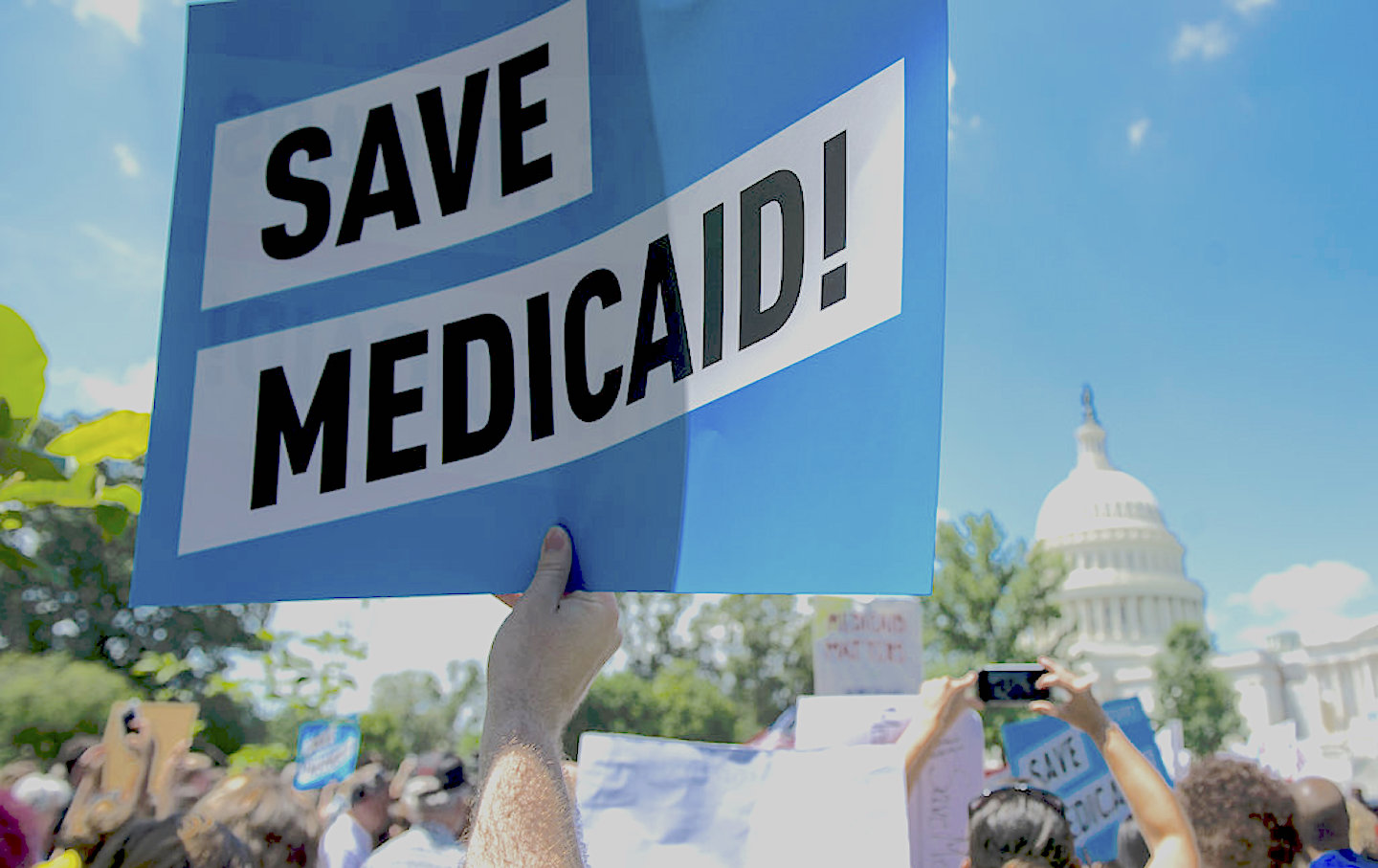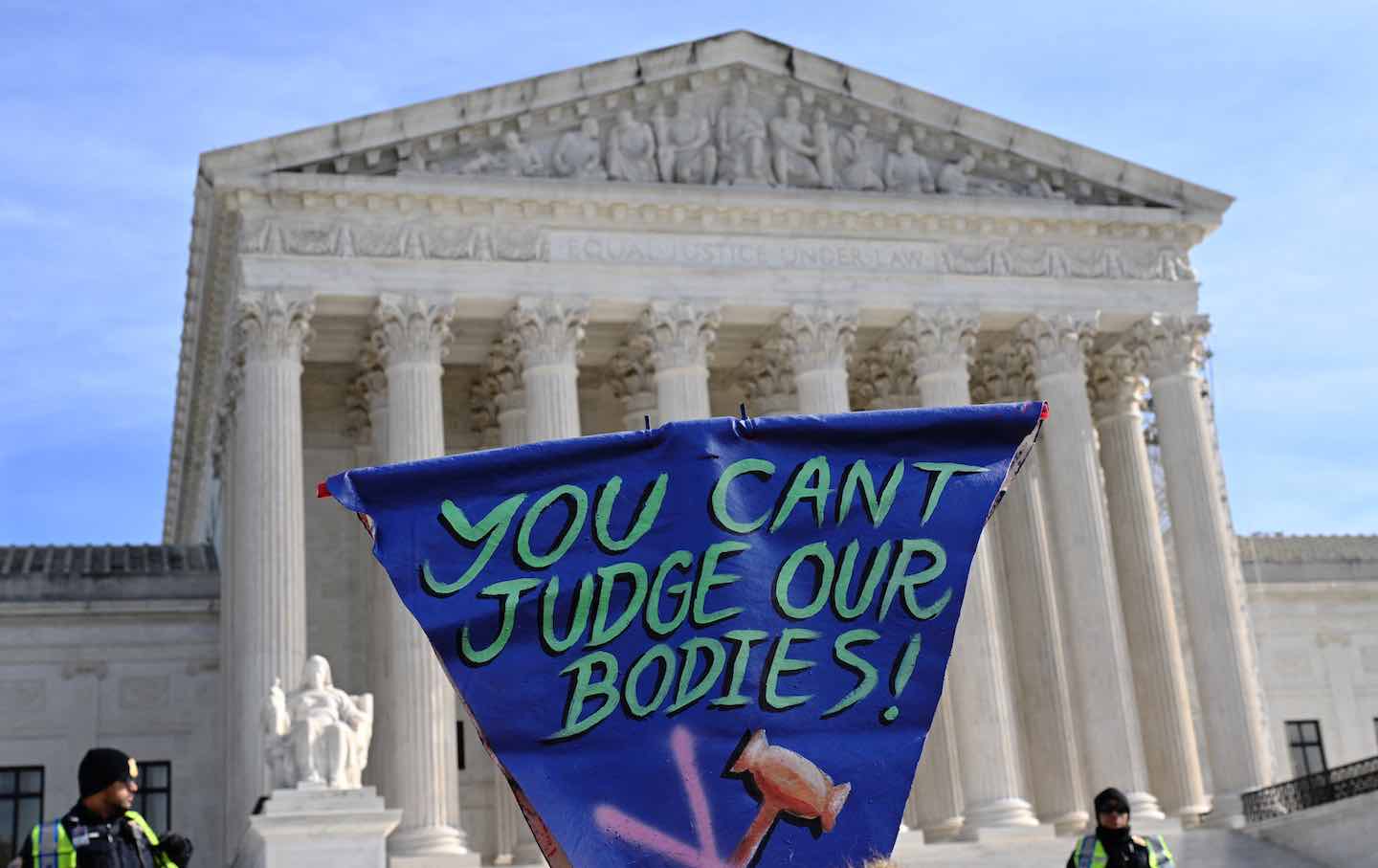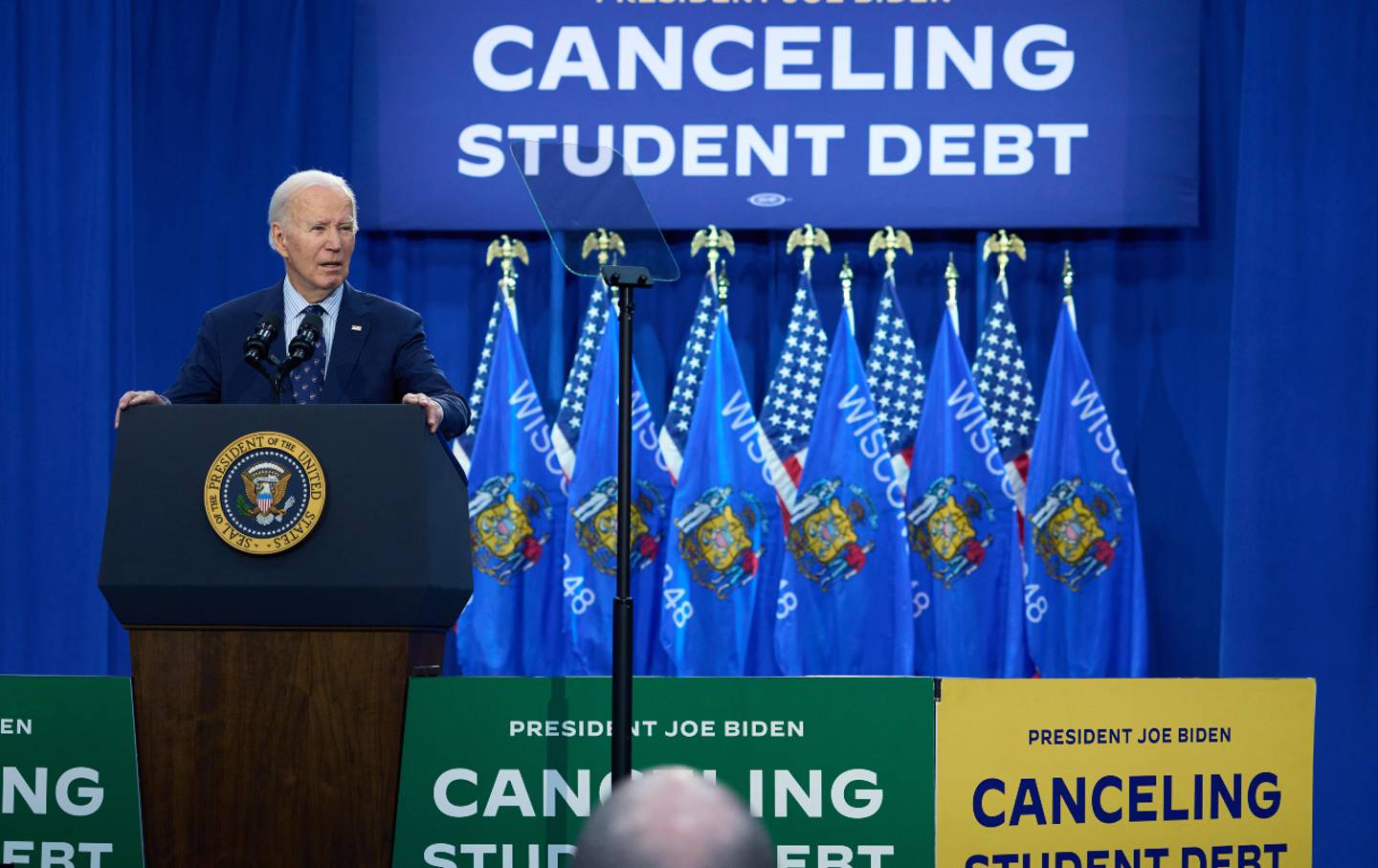The Great Medicaid Unwinding
Millions of Americans lost their coverage earlier this year when a pandemic-era policy expired. The consequences are detrimental to the very practice of medicine.

Participants hold signs during the Senate Democrats’ rally against Medicaid cuts in front of the US Capitol in June 2017.
(Bill Clark / CQ Roll Call via AP Images)Ronald Reagan’s ascent to the presidency delivered a swift kick to the nation’s poor—especially those who had the misfortune to get sick. His administration’s 1981 budget imposed deep cuts on Medicaid, adding to financial pressures on states to narrow eligibility and punting some 600,000 beneficiaries out of the program early in the decade. A 1983 study in The New England Journal of Medicine examined the health consequences of Medicaid cuts in California, where coverage was eliminated for 270,000 people. One study subject who lost coverage died of a brain bleed (she couldn’t afford the blood pressure-lowering medications that might have prevented it), another of a stomach ulcer (he spit up blood for 10 days before seeking care, fearing ER bills), and a third of a probable heart attack (he ran out of heart medications which he couldn’t afford to refill). This episode is of more than historic interest: We are now about six months into our own version of what experts are calling a great “Medicaid unwinding.”
In April, the pandemic-era “continuous coverage provision”—which compelled states to keep Medicaid beneficiaries continuously insured for the duration of the Covid-19 public health emergency, greatly boosting enrollment—expired. This has already led to the disenrollment of nearly 8 million beneficiaries from the program, with predictable results. For example, Patricia Jones, a 62-year old West Virginia woman with heart problems and a recent bloodstream infection, was recently dropped from Medicaid because the $1,765 a month she was getting in disability survivor’s benefits after her husband died in March was $149 too high to qualify, The Washington Post recently reported. (She has yet to find alternative coverage.) Experts predict that as many as 24 million enrollees might lose their coverage by the time the unwinding is done.
These giant numbers dwarf the coverage losses of the early 1980s, and widespread harm is sure to follow. But the so-called “Medicaid unwinding” isn’t as new as it may seem. Before the pandemic, large numbers of people lost Medicaid coverage every year, thanks to shifting eligibility at the margins and administrative snafus. This feature—inherent to many means-tested programs—has always compromised coverage and caused suffering for those who depend on this critical program. Such discontinuities in coverage are all too common in the fragmented American insurance system, and they undermine the very essence of what medical care can do.
Ipractice ICU medicine in Massachusetts, a state where only 2.5 percent of residents are uninsured—and which might hence be counted as the ultimate American health coverage success story. I no doubt see less medical deprivation than my colleagues in states like Texas, where the uninsured rate hovers around 18 percent. Still, I see how discontinuities in coverage entrenched by a patchwork system affect my patients’ lives. Those gaps can precipitate potentially deadly ruptures of care. Inability to fill an insulin prescription because of a lapse or change in coverage, for instance, can provoke acute, even life-threatening diabetic emergencies that land a patient in the ICU.
Even when coverage interruptions aren’t acutely life-threatening, they invariably detach patients from the healthcare system and erode the ongoing mutual project that ought to be the bedrock of effective medical care. Most of the benefits of modern healthcare, after all, emerge not from emergency care provided in places like ERs or ICUs, as important as that is. Rather, health is protected through long-standing therapeutic relationships between patients and primary care physicians that allow medical problems to be recognized and chronic problems carefully managed. Patients with untreated high blood pressure who are excluded from such care, for instance, may experience a slow and silent deterioration of their kidney and heart function—until the day fluid fills their lungs and they wind up in an ICU seeing someone like me. Ongoing relationships with trusted primary care providers can likewise help assure many of the safety—or the urgency—of interventions like Covid-19 vaccination. Those excluded may pay the price, winding up with severe, life-threatening Covid pneumonia in the ICU.
Numerous studies bear this out. One study, for instance, found that about a quarter of low-income individuals experience coverage disruptions over the course of a year; individuals with such interruptions in coverage are more likely to have to change doctors or prescriptions, to skip doses of their medications, to go the ER, or to report worse health compared to those with continuous coverage. Even though the Covid-19 vaccines were free, colleagues and I found that health coverage and access to care are associated with higher booster uptake. Another of our studies identified a sharp rise in hospitalizations for diabetic emergencies when teens became young adults in the US—a time of frequent coverage disruptions—but not in Canada, where insurance is universal and seamless across the life course.
Other work highlights the critical importance of a relationship with a primary care physician—precluded by lapses or even changes in coverage. A clinical trial published decades ago found that older veterans who were randomized to “continuous” primary care (i.e., seeing the same provider regularly) spent fewer days in the hospital and the ICU than those who were randomized to discontinuous care. This year, a quasi-experimental study found that when Medicare beneficiaries lose their primary care physician, they experience a 3 percent increase in hospital admissions and a jaw-dropping 4 percent increase in mortality. Medical care that is disjointed and discontinuous, that is to say, may not amount to care at all.
Since its inception, Medicaid has been on the front lines of the battle for an American welfare state. In 1964, Democrats swept the midterm elections, giving them the congressional majorities they needed to finally realize long-fought-for healthcare reform. The following year, President Lyndon Johnson signed both Medicare and Medicaid into law. Medicare was designed in the universal social insurance mold: It provided something of a national statuary right to healthcare for almost all older Americans. Medicaid, in contrast, entered the world as a means-tested program, partially funded (and controlled) by states, with eligibility initially generally confined to the so-called “categorically needy”—individuals who were not merely poor but who also participated in certain welfare programs. While Medicaid’s out-of-pocket payments are generally low or even zero, the program provides access to a narrower scope of providers compared to traditional Medicare. Medicaid is also subject to the whims and prejudices of state lawmakers, who have significant latitude to cut eligibility criteria or benefits, sometimes cruelly. Still, since its inception, Medicaid program has greatly expanded, and improved—particularly as a result of the President Barack Obama’s Affordable Care Act, which was designed to make all low-income individuals eligible.
The expansion of Medicaid has had large, extensively documented benefits: it improves access to healthcare services and health itself, and, indeed, has saved numerous lives. Still, the much-needed rise in participation achieved by the continuous coverage provision—enrollment rose from 71 million to 94 million from January 2020 to April 2023—was at the same time a testament to how much “churn,” or movement in-and-out of the program, occurs outside plague years when such protections are not in play. Small increases in family income can render someone ineligible for Medicaid. Moving states can provoke disenrollment. There are sometimes burdensome administrative hurdles to enrollment, which can be particularly challenging for workers with unsteady employment or income or otherwise tenuous life circumstances. Annual eligibility redeterminations can result in disenrollment if forms are not properly completed, or when they are sent by state agencies to the wrong address.
A string of news stories before the pandemic revealed how common such disenrollment normally is, at least in many states. In 2018, some 70,000 people, mostly children, were dropped from Missouri’s Medicaid program, mostly “because they failed to reply to a mailed renewal form,” according to NPR. A 2019 story in The Texas Tribune described how the state used an automated system to check family income multiple times a year to validate children’s ongoing eligibility, which caused thousands of children to lose coverage every month, sometimes in error. The same year, The Tennessean reported that 120,000 had been dropped from Tennessee’s Medicaid program since 2017: “Nearly all of these disenrollments occurred when the state government processed insurance renewals with an outdated system of paper forms and postal mail,” the paper noted. Similarly, in Idaho, a large number of children were dropped from Medicaid in the years before the pandemic thanks to a more onerous state enrollment system that was at least in part driven by guidance from the Trump administration, ProPublica found. None of these are aberrations: one recent study found that Medicaid participants have a roughly 20 percent chance of having a lapse in coverage over a given two-year period.
Just how many victims of today’s “Medicaid unwinding” will find alternate coverage and how many will remain uninsured isn’t yet clear. But there’s little doubt that many will be harmed. Research has found that Medicaid expansion saves lives; it is a reasonable extrapolation of these findings to say that contraction will take some.
The continuous coverage provision should be seen as two things at once: a successful example of what action born of an emergency can achieve, but also an indictment of the pre-pandemic status quo. Uniquely among high-income nations, we allow our residents to periodically, and protractedly, lose healthcare, and to suffer as a result. Achieving the goal of universal coverage is a moral imperative. Yet any vision of universal healthcare worthy of the name must provide seamless, cradle-to-grave healthcare to everyone. Without continuity, there is, far too often, no care at all.
More from The Nation

What Luigi Mangione and Daniel Penny Are Telling Us About America What Luigi Mangione and Daniel Penny Are Telling Us About America
When social structures corrode, as they are doing now, they trigger desperate deeds like Mangione’s, and rightist vigilantes like Penny.

Banning Trans Health Care Puts Young People at Risk of Harm Banning Trans Health Care Puts Young People at Risk of Harm
Contrary to what conservative lawmakers argue, the Supreme Court will increase risks by upholding state bans on gender-affirming care.

It’s Still Not Too Late for Biden to Deliver Debt Relief It’s Still Not Too Late for Biden to Deliver Debt Relief
Four years after hearing the president promise bold action on student debt, most borrowers are still no better off, and many—especially defrauded debtors—are measurably worse off....

It’s Been a Tough Year. Let’s Help Each Other Out. It’s Been a Tough Year. Let’s Help Each Other Out.
There may be a dark shadow hanging over this year’s holiday season, but there are still ways to give to those in need.

Prison Journalism Is Having a Renaissance. Rahsaan Thomas Is One of Its Champions. Prison Journalism Is Having a Renaissance. Rahsaan Thomas Is One of Its Champions.
Thomas and his colleagues at Empowerment Avenue are subverting the established narrative that prisoners are only subjects or sources, never authors of their own experience.

Luigi Mangione Is America Whether We Like It or Not Luigi Mangione Is America Whether We Like It or Not
While very few Americans would sincerely advocate killing insurance executives, tens of millions have likely joked that they want to. There’s a clear reason why.


